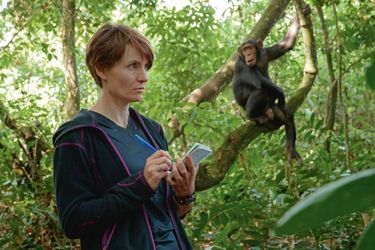Makakou, that morning, is all woozy. He does not eat, drags himself in the forest then stops in front of a Trichilia rubescens, as a human would stop in front of a pharmacy. None of this shrub is part of its usual snack. However, the chimpanzee catches young leaves, which he begins to chew. Not terrible in taste, but very effective in reducing fever. Then he finds clay between the roots of a fallen tree and swallows a pellet. “One day of this treatment and he was back in great shape,” recalls Sabrina Krief, who assigns a first name to each of the individuals she follows.
For more than twenty years, the primatologist from the National Museum of Natural History has been studying the feeding behavior of chimpanzees and the way in which they “self-medicate” in Kibale National Park, Uganda. Its goal: to better understand them to better protect the ecosystem of this endangered species, but also to discover new molecules capable of treating humans. “I was all the more intrigued that local people use trichilia as a painkiller,” she continues. Back in her laboratory in France, she analyzes a sample of the plant and discovers molecules capable of killing the parasites responsible for malaria. Then, by recreating the conditions of digestion, she notices that the clay ingested increases the effectiveness of the medicinal plant. Clever, this great ape! “In fact, he had developed his own prescription,” says the specialist in zoopharmacognosy.
”
Only sick individuals ingest these plants as a remedy, which confirms a behavior of self-medication
“
This science, which studies the behavior of self-medication in wild animals, was born with Richard Wrangham, of Harvard University. At the end of the 1970s, the American anthropologist, who followed the chimpanzees of Gombe, in Tanzania, noted that some of them succeeded in getting rid of parasites which twisted their bellies. Their prescription? Swallow without chewing the rough leaves of an Aspilia mossambicensis, in which the worms will find themselves trapped. About 15% of the 300 parts of plants consumed by the chimpanzees that Sabrina studies have therapeutic properties. Pay attention to the dosage! Often harsh or bitter, these are toxic; but, consumed in small quantities, they have curative powers. “Only sick individuals ingest them as a remedy, which confirms self-medication behavior,” explains the scientist.
A consumption very observed by young and old: that of neoboutonia dead wood, low in calories, whose medicinal properties are being studied.
© Jean-Michel Krief
For the great apes, the forest is a formidable open-air pharmacy. They find everything they need to treat diarrhoea, parasites, coughs or skin infections. The most surprising thing is that this medical culture is not innate. It is linked to a keen sense of observation: at any age, chimpanzees learn from their elders. The most scrutinized by their peers when they eat unusual plants are the 25-35 year olds, males or females in the prime of life, who know their environment like the back of their hand. Of course, the mother is the first teacher. But don’t count on her to take care of her little one. Sabrina says she has never seen a mother handing her child a plant that she was not eating herself: “Chimpanzees take care of themselves but they are neither doctors nor pharmacists! Although… A recent study, conducted in Loango National Park, Gabon, by German researchers shows that to help with healing, chimpanzees apply unidentified insects not only to their own wounds but also to those of their friends.
”
Most of the plants they consume are endemic and unfortunately impossible to use in our pharmacopoeia
“
Even if they have not completed ten years of medical studies, the great apes could well give lessons in matters of health to their learned cousins. “They treat themselves better than humans because they still know what is good for them,” says Isabelle Pacchioni, expert in aromatic plants. The founder (with her husband, Marco Pacchioni) of Puressentiel, the brand of essential oils and plant extracts, took advantage of a trip to Rwanda to see the gorillas: “As they are very good professors of botany, I was interested in approaching them. But most of the plants they consume are endemic and unfortunately impossible to use in our pharmacopoeia, because they are not listed in the lists of medicinal products authorized in Europe. »
For 1,500 dollars, tourists, accompanied by rangers, can meet these mountain giants from afar, whose population has been increasing slowly since they were protected: 400 individuals in the Volcanoes National Park, according to the latest census. “Researchers have observed that they treat the symptoms of malaria by consuming certain leaves, in particular those of Secamone africana, also used by the locals, continues Isabelle Pacchioni. They also feast on the Yushania alpinea bamboo, called “gorilla whiskey”, which excites them and makes them kick their chests a la King Kong. »
The gorilla’s digestive system is able to detoxify medicinal plants
They consume everything without moderation. Not the kind, like chimpanzees, to be wary, to select, to wait for the first symptoms… “Their digestive system is more resistant”, explains Shelly Masi, specialist in lowland gorillas in the west of the Central African Republic. “The intestine of the chimpanzee, an occasional consumer of meat, resembles that of humans. That of the gorilla, which is more vegetarian, is much longer and filled with bacteria capable of detoxifying medicinal plants. They are part of their regular diet because they can eat as much as they want. They consume them as a basic treatment, in a way! »
Prevention is the secret of their Olympic form! In five years of continuous observation, the Italian scientist, also a primatologist at the National Museum of Natural History, says that she has only observed a sick gorilla once: he was suffering from severe diarrhea. These large primates make their daily living with aframomum, a herbaceous plant from the ginger family with antibacterial, antiviral and antifungal properties, or even Thomandersia hensii, with antimalarial properties. More rarely, they swallow the leaves of a shrub defended by huge ants, virulent as wasps. If they agree to be stung, it is because there are interesting properties behind them, in particular anti-inflammatory and painkiller. The plant is also used during childbirth by the Aka Pygmies, a people who live in the forest, in the south of the Central African Republic.

Sabrina Krief with Kimchi. The primatologist never approaches within ten meters of the chimpanzees she studies so that they remain wild.
© Jean-Michel Krief
These hunter-gatherers use 10% of the 120 plants eaten by the region’s gorillas, especially those that serve as their vermifuge. Proof of the interest in the pharmacopoeia of great apes: a university team from Kinshasa, in collaboration with Shelly Masi, has listed the plants eaten by gorillas in the eastern lowlands, in the Democratic Republic of Congo. Scientists hope that pharmaceutical laboratories will take an interest in it and develop drugs for African populations, who do not always have access to modern medicine.
Also read. Medicines of tomorrow: the future is in the tropics
Does the great ape therefore provide clues for treating humans? In the meantime, the latter continues to make him sick. While Shelly Masi is currently working on the oxidative stress of the gorilla linked to global warming, Sabrina Krief is studying the facial malformations of baby chimpanzees due to pesticides. She resumed observations in the field. During the pandemic, Sabrina avoided following in the footsteps of her protégés so as not to risk transmitting the Covid to them. Not sure that the great apes would have the plant capable of ridding them of coronaviruses in their pharmacy.

Marco and Isabelle Pacchioni (right) in a center for disabled children in Rwanda. With Nadine Jonglez de Ligne, from the association Harmonious Initiatives.
© Jean-Michel Krief
The Puressentiel Foundation in Rwanda
Watching gorillas was not the only reason for their trip: the ultimate goal was the children. Through the Puressentiel Foundation, Isabelle and Marco Pacchioni support the Harmonious Initiatives association, which takes care of 130 orphans and young people with no schooling or disabilities. “We bring them food and school supplies. A child helped benefits the whole family,” explains Isabelle. Forty-two projects linked to the protection of children, health or biodiversity have already been supported throughout the world. This year, there will be twenty more. On June 22, the Puressentiel Foundation, partner for nineteen years of the Grand Prix Paris Match for student photoreportage, will award the Nature and Environment prize.
